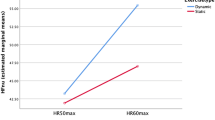Summary
During a constant dynamic work a static work was performed by two subjects. Following the static work an increase of the pulse rate recorded and it was shown that the increase of the pulse rate was respectively 11 and 8 beats more per minute than predicted.
The disproportion between the increase of the pulse rate and the increase of the oxygen consumption induced by the static work is discussed. It is found most likely that this observation may be explained by a nervous regulation of the heart rate initiated by a stimulus of constant nature.
Finally, it is stressed that the pulse rate does not elucidate the fatigue induced by the static work.
Similar content being viewed by others
References
Asmussen, E., andE. Hansen: Scand. Arch. Physiol.78, 283 (1938).
Berggren, G., andE. H. Christensen: Arbeitsphysiologie14, 255 (1950).
Karrasch, K., andE. A. Müller: Arbeitsphysiologie14, 369 (1951).
Lehmann, G.: Praktische Arbeitsphysiologie, p. 41. Stuttgart: Thieme 1953.
Lundgren, N.: Acta physiol. soandin.13, Suppl. 41 (1946).
Müller, E. A.: Arbeitsphysiologie12, 92 (1942);19, 271 (1956).
Author information
Authors and Affiliations
Rights and permissions
About this article
Cite this article
Hansen, O.E., Maggio, M. Static work and heart rate. Int. Z. Angew. Physiol. Einschl. Arbeitsphysiol. 18, 242–247 (1960). https://doi.org/10.1007/BF00693583
Received:
Published:
Issue Date:
DOI: https://doi.org/10.1007/BF00693583




